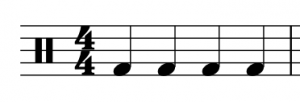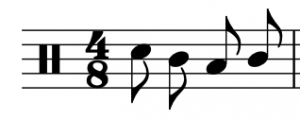2 Simple Meter and Time Signatures
Chelsey Hamm; Kris Shaffer; and Mark Gotham
Key Takeaways
- A beat is a pulse in music that regularly recurs.
- Simple Meters are meters in which the beat divides into two, and then further subdivides into four.
- Duple Meters have groupings of two beats, Triple Meters have groupings of three beats, and Quadruple Meters have groupings of four beats. You can determine these groupings aurally by listening carefully and tapping along to the beat.
- There are different conducting patterns for Duple, Triple, and Quadruple meters.
- A measure is equivalent to one group of beats (Duple, Triple, or Quadruple). Measures are separated by bar lines.
- Time signatures in simple meters express two things: how many beats are contained in each measure (the top number), and the beat unit (the bottom number), which refers to the note value that is the beat.
- Notes in simple meters get different counts based upon their beat unit. Beats that are not counted out loud (because they contain more than one beat or because of ties, rests, or dots) have written parentheses around their counts.
- A beam connects notes by beat. Beaming changes in different time signatures.
- Notes below the middle line on a staff are down-stemmed, while notes above the middle line on a staff are up-stemmed. Flag direction works similarly.
- When two or more notes are beamed together, the stem direction is dictated by the note furthest from the middle line.
In Rhythmic and Rest Values we discussed the different rhythmic values of notes and rests. Musicians organize rhythmic values into various meters, which are—broadly speaking—formed as the result of recurrent patterns of accents in musical performances.
Terminology
Listen to the following performance by the contemporary musical group Postmodern Jukebox (PMJ). They are performing a cover of the song “Wannabe” by the Spice Girls (originally released in 1996), as heard in Example 1.
Example 1. A cover of “Wannabe” performed by Postmodern Jukebox; listen starting at 0:11.
Beginning at 0:11, it is easy to tap or clap along to this recording. What you are tapping along to is called a beat—a pulse in music that regularly recurs.
Simple Meters are meters in which the beat divides into two, and then further subdivides into four. Example 1 is in a simple meter. You can feel this yourself, by tapping your beat twice as fast; you might also think of this as dividing your beat into two smaller beats.
Different numbers of beats group into different meters. Duple Meters contain beats which are grouped into twos, while Triple Meters contain beats which are grouped into threes, and Quadruple Meters contain beats which are grouped into fours.
Listening to Simple Meters
Let’s listen to examples of Simple Duple, Simple Triple, and Simple Quadruple meters. A Simple Duple meter contains two beats, each of which divides into two (and further subdivides into four). “The Stars and Stripes Forever” (1896), written by John Philip Sousa, is in a Simple Duple meter.
Listen to Example 2, and tap along, feeling how the beats group into sets of two:
Example 2. “The Stars and Stripes Forever” played by the Dallas Winds.
A Simple Triple meter contains three beats, each of which divides into two (and further subdivides into four). The third movement of Symphony no. 90 (1788), written by Franz Joseph Haydn, is in a Simple Triple meter. Listen to Example 3, and tap along, feeling how the beats group into sets of three:
Example 3. Movement 3 of Symphony No. 90, by Franz Joseph Haydn, played by the Orchestra of the 18th Century.
Finally, a Simple Quadruple meter contains four beats, each of which divides into two (and further subdivides into four). The song “Cake” (2017), by Flo Rida, is in a Simple Quadruple meter. Listen to Example 4 starting at 0:45, and tap along, feeling how the beats group into sets of four:
Example 4. “Cake” by Flo Rida; listen starting at 0:45.
As you can hear and feel (by tapping along) musical compositions in a wide variety of styles are governed by meter. You might practice identifying the meters of some of your favorite songs or musical compositions as Simple Duple, Simple Triple, or Simple Quadruple; listening carefully and tapping along is the best way to do this. Note that Simple Quadruple meters feel similar to Simple Duple meters, since four (beats) are divisible by two (beats). It may not always be immediately apparent if a work is in a Simple Duple or Simple Quadruple meter by listening alone.
Conducting Patterns
If you have ever sang in a choir or played an instrument in a band or orchestra, then you have likely had experience with a conductor. Conductors have many jobs. One of these jobs is to provide conducting patterns for the musicians in their choir, band, or orchestra. Conducting patterns serve two main purposes: first, they establish a tempo, and second, they establish a meter.
The three most common conducting patterns outline Duple, Triple, and Quadruple meters. Duple meters are conducted with a downwards/outwards motion (step 1), followed by an upwards motion (step 2), as seen in Example 5. Triple meters are conducted with a downwards motion (step 1), an outwards motion (step 2), and an upwards motion (step 3), as seen in Example 6. Quadruple meters are conducted with a downwards motion (step 1), an inwards motion (step 2), an outwards motion (step 3), and an upwards motion (step 4), as seen in Example 7.
Beat 1 of each of these measures is considered a downbeat . A downbeat is conducted with a downwards motion, and you may hear and feel that it has more “weight” or “heaviness” then the other beats. An upbeat is the last beat of any measure. Upbeats are conducted with an upwards motion, and you may feel and hear that they are anticipatory in nature.
Example 8 shows a short video demonstrating these three conducting patterns:
https://www.youtube.com/watch?v=EEQezQNVldo
Example 8. Dr. John Lopez (Christopher Newport University) demonstrates Duple, Triple, and Quadruple conducting patterns.
You can practice these conducting patterns while listening to Example 2 (Duple), Example 3 (Triple), and Example 4 (Quadruple) above.
Time Signatures
In Western musical notation, beat groupings (duple, triple, and quadruple) are created by bar lines, which separate music into measures, which are also called bars. Example 9 shows bar lines and measures:

Each measure is equivalent to one beat grouping. In simple meters, time signatures express two things: how many beats are contained in each measure, and the beat unit—which note value is the beat. Time signatures (also called meter signatures) are expressed by two numbers, one above the other, as seen in Example 10.

Time signatures may look like a fraction but they are not one; noticeably, there is no line in between the two numbers of a time signature. Time signatures come after a clef.
The top number of a time signature in simple meter represents the number of beats in each measure. The bottom number of a time signature represents the beat unit. The number “4” means that a quarter note gets the beat.
In simple meters, the top number is always “2,” “3,” or “4,” corresponding to duple, triple, or quadruple beat patterns. The bottom number is usually one of the following:
- “2” which means the half note gets the beat
- “4” which means the quarter note gets the beat
- “8” which means the eighth note gets the beat
Two other bottom numbers do appear in simple meter time signatures. If “16” appears as the bottom number then the sixteenth note gets the beat, while if “1” appears as the bottom number then the whole note gets the beat.
There are two additional simple meter time signatures which are ![]() (common time) and
(common time) and ![]() (cut time). Common time is the equivalent of
(cut time). Common time is the equivalent of ![]() (simple quadruple—four beats per measure), while cut time is the equivalent of
(simple quadruple—four beats per measure), while cut time is the equivalent of ![]() (simple duple—two beats per measure).
(simple duple—two beats per measure).
Counting in Simple Meter
Counting rhythms is important for musical performance; as a singer or instrumentalist you must be able to perform rhythms that are written in Western musical notation. Conducting while counting rhythms will help you to keep a steady tempo and is highly recommended. Example 11 shows a rhythm in a ![]() time signature, which is a simple quadruple meter:
time signature, which is a simple quadruple meter:
Example 11. Rhythm in 4/4 time.
This time signature means that there are four beats per measure (the top “4”), and that the quarter note gets the beat (the bottom “4”). Each quarter note gets a count—1, 2, 3, 4—in each measure. Counts are expressed with Arabic numerals. Notes that are longer in duration than the beat (such as a half or whole note in this example) are held over multiple beats. Beats that are not counted out loud are written in parentheses.
Please note that your instructor, high school, college, or university may employ a different counting system. Open Music Theory privileges American traditional counting, but this is not the only method.
Example 12 shows how divisions (eighth notes) and subdivisions (sixteenth and thirty-second notes) are counted:
Example 12. The counting for divisions and subdivisions.
The divisions are counted as the syllable “and,” which is usually notated with a “+.” Further subdivisions at the sixteenth-note level are counted as “e” (pronounced as a long vowel such as the word see) and “a” (pronounced “uh”). Further subdivisions at the thirty-second-note level add the syllable “ta” in between each of the previous syllables.
Simple duple meters have only two beats, as shown in Example 13.
Example 13. Simple duple meters have two beats per measure.
While simple triple meters have three beats, as shown in Example 14.
Example 14. Simple triple meters have three beats per measure.
Beats that are not articulated because of rests, ties, and dots, are also not counted out loud. These beats are usually written in parentheses, as shown in Example 15.
Example 15. Beats that are not counted out loud are put in parentheses.
A pickup note, also known as an anacrusis, is a note that happens before the first measure of a musical work. There can be more than one pickup note in a piece. An anacrusis is counted as the last note (or last notes) of an imaginary measure. Example 16 shows that this note would be counted as beat 4 (not beat 1):
Example 16. The anacrusis is counted as beat 4 of an imaginary measure.
Please note that the last measure in a work with an anacrusis is usually shortened by the length of the anacrusis. Example 16 demonstrates this; there is an anacrusis that is one quarter note in length. Therefore, the last measure of the example is only three beats in length (i.e. it is missing one quarter note).
Counting with Beat Units of 2, 8, and 16
Simple meters with other beat units (the bottom number of a time signature) are counted differently because a different note value gets the beat. Example 17 shows a rhythm with a ![]() time signature:
time signature:
Example 17. A counted rhythm with the beat unit of a quarter note.
Example 18 shows the same rhythm with the half note as the beat unit:
Example 18. A counted rhythm with the beat unit of a half note.
Example 19 shows the same rhythm with the eighth note as the beat unit:
Example 19. A counted rhythm with the beat unit of an eighth note.
Example 20 shows the same rhythm with the sixteenth note as the beat unit:
Example 20. A counted rhythm with the beat unit of a sixteenth note.
Each of these rhythms sound the same, and are counted the same. They are also all considered simple quadruple meters. The difference in each example is the bottom number—which note gets the beat unit (quarter, half, eighth, or sixteenth).
Beaming, Stems, Flags, and Multi-measure Rests
In simple meters, beams connect notes together by beat; beaming therefore changes in different time signatures. This is demonstrated in Example 21.
Example 21. Beaming in two different meters.
In the first measure of Example 21, sixteenth notes are grouped into sets of four, because four sixteenth notes in a ![]() time signature are equivalent to one beat. In the second measure of Example 21, sixteenth notes are grouped into sets of two, because two sixteenth notes in a
time signature are equivalent to one beat. In the second measure of Example 21, sixteenth notes are grouped into sets of two, because two sixteenth notes in a ![]() time signature are equivalent to one beat.
time signature are equivalent to one beat.
Please note that beaming is sometimes not used in vocal music, although it is almost always used to connect notes sung on the same syllable. If you have not sung a lot of beamed music, you may need to pay special attention to beaming conventions, until you have mastered them.
In Example 22, the eighth notes are not grouped with beams, making it difficult to interpret the triple meter:

If we re-notate the above example so that the notes that fall within the same beat are grouped together with a beam, it makes the music much easier to read, as seen in Example 23.
Example 23. Rhythms that are beamed according to the meter are usually easier to read.
Note that Example 22 and Example 23 sound the same, even though they are beamed differently. This beaming helps because the ability to group events hierarchically is an important part of the human perceptual experience, and the visual parsing of notated musical rhythms is no exception. We have a hierarchy in the form of a metrical structure, and we use our notational tools to show it!
Example 24 shows several different ways to beam beats in this same time signature:

Each line starts with unbeamed notes on the left, and the same rhythm beamed properly (where applicable) on the right. The first line does not require beams because quarter notes are never beamed, but all subsequent lines do need beams to clarify beats.
The stems of notes can point either upwards (on the right side of a note) or downwards (on the left side of a note). For notes above the middle line, the stem points downwards, and for notes below the middle line stems point upwards. Notes on the middle line can point in either direction. This is shown in the first measure of Example 25.

As you can see in the second measure of Example 25, when notes are grouped together with beams the stem direction is determined by the note furthest from the middle line. On beat one of measure 2 this note is E5; E5 is above the middle line, which means downwards stems are used. On beat two of measure 2 this note is E4; E4 is below the middle line, which means upward stems are used.
Flagging is determined by stem direction. Notes above the middle line receive a downwards stem (on the left) and an inwards-facing flag (facing right). Notes below the middle line receive an upwards stem (on the right) and an outwards-facing flag (facing left). Notes on the middle line can be flagged in either direction, usually depending on the contour of the musical line. This is demonstrated in Example 26.

Partial beams can be used for mixed rhythmic groupings, as shown in Example 27.

Sometimes these beaming conventions look strange to students who have had less experience with reading beamed music. If this is the case, you will want to pay special attention to how the notes in Example 27 are beamed.
Rests that are multiple measures are sometimes notated as seen in Example 28.

This notation indicates that the musician is to rest for a duration of four full measures.
A Note on Ties
We have already encountered ties which can be used to extend a note over a measure line. But ties can also be used like beams to clarify the metrical structure within a measure. Here’s a case where it can be helpful (note the combination of tie and beams), in Example 29.

As you can see in Example 29, ties are used to break up the note that traverses from the end of the first beat to the start of the second, leading to a clearer rhythm overall.
- Simple Meter Tutorial (musictheory.net)
- Video Tutorial on Simple Meter, Beats, and Beaming (YouTube)
- Conducting Patterns (John Buccheri)
- Simple Meter Time Signatures (liveabout.com)
- Video Tutorial on Counting Simple Meters (One Minute Music Lessons)
- Simple Meter Counting (YouTube)
- Beaming Rules (Music Notes Now)
- Beaming Examples (Dr. Sebastian Anthony Birch)
- Time Signatures and Rhythms (Easy) (.pdf)
- Terminology, Bar lines, Fill-in-rhythms, Re-beaming (.pdf)
- Meters, Time Signatures, Re-beaming (website)
- Bar Lines, Time Signatures, Counting (.pdf)
- Time Signatures, Re-beaming (p. 4) (.pdf)
- Fill-in-rhythms (.pdf)
- Time Signatures (.pdf, .pdf)
- Bar Lines (.pdf, .pdf, .pdf)
Media Attributions
- Measures and Barlines © Nathaniel Mitchell is licensed under a Public Domain license
- Time Signature © Chelsey Hamm is licensed under a Public Domain license
- Notes Without Beams © Mark Gotham is licensed under a Public Domain license
- Beaming Breakdown © Mark Gotham is licensed under a Public Domain license
- Stemming © Chelsey Hamm is licensed under a Public Domain license
- Flag Direction © Chelsey Hamm is licensed under a Public Domain license
- Partial Beams © Megan Lavengood is licensed under a Public Domain license
- Multi-Measure Rest © Chelsey Hamm is licensed under a Public Domain license
- Ties Clarify Beats © Mark Gotham is licensed under a Public Domain license

